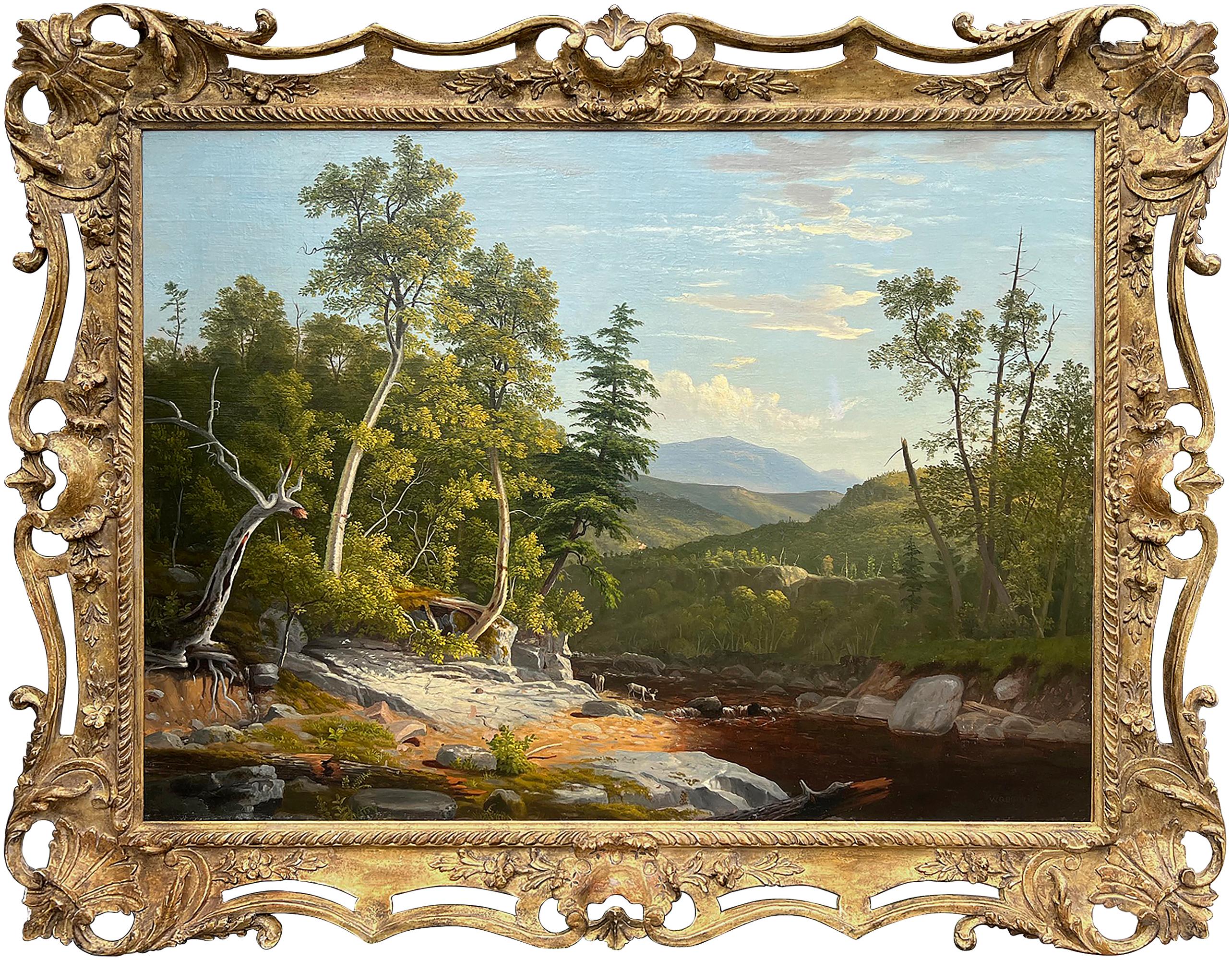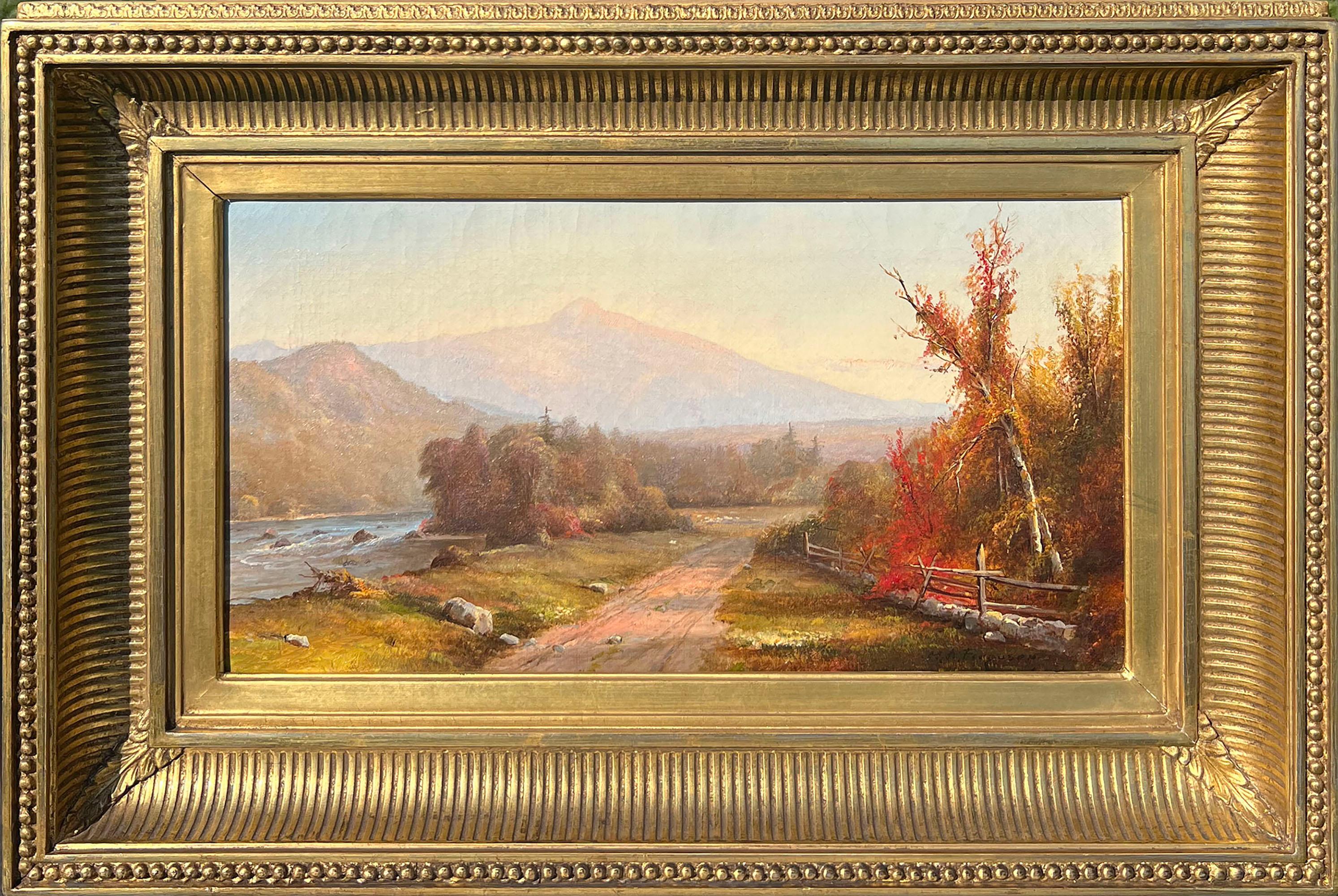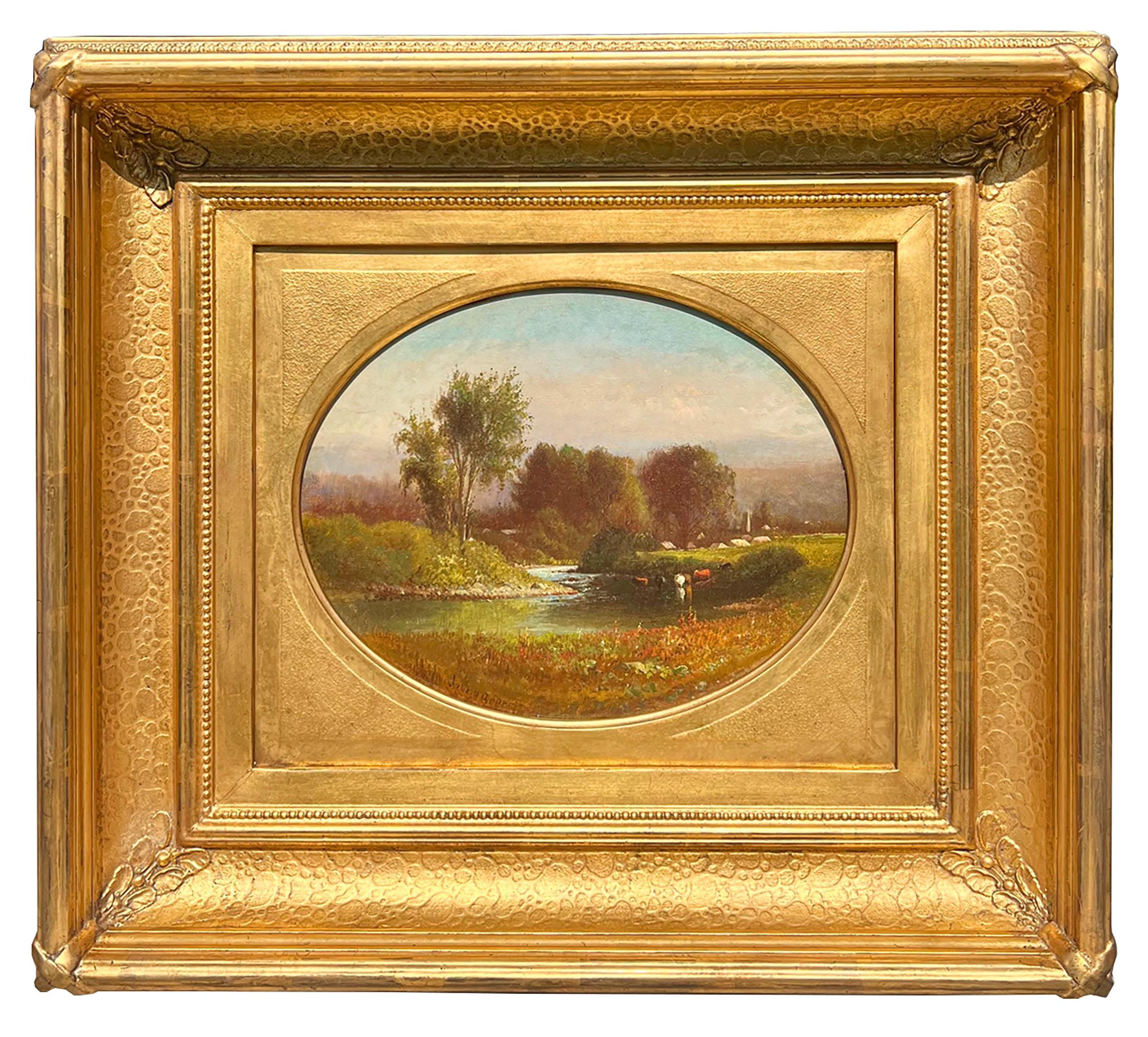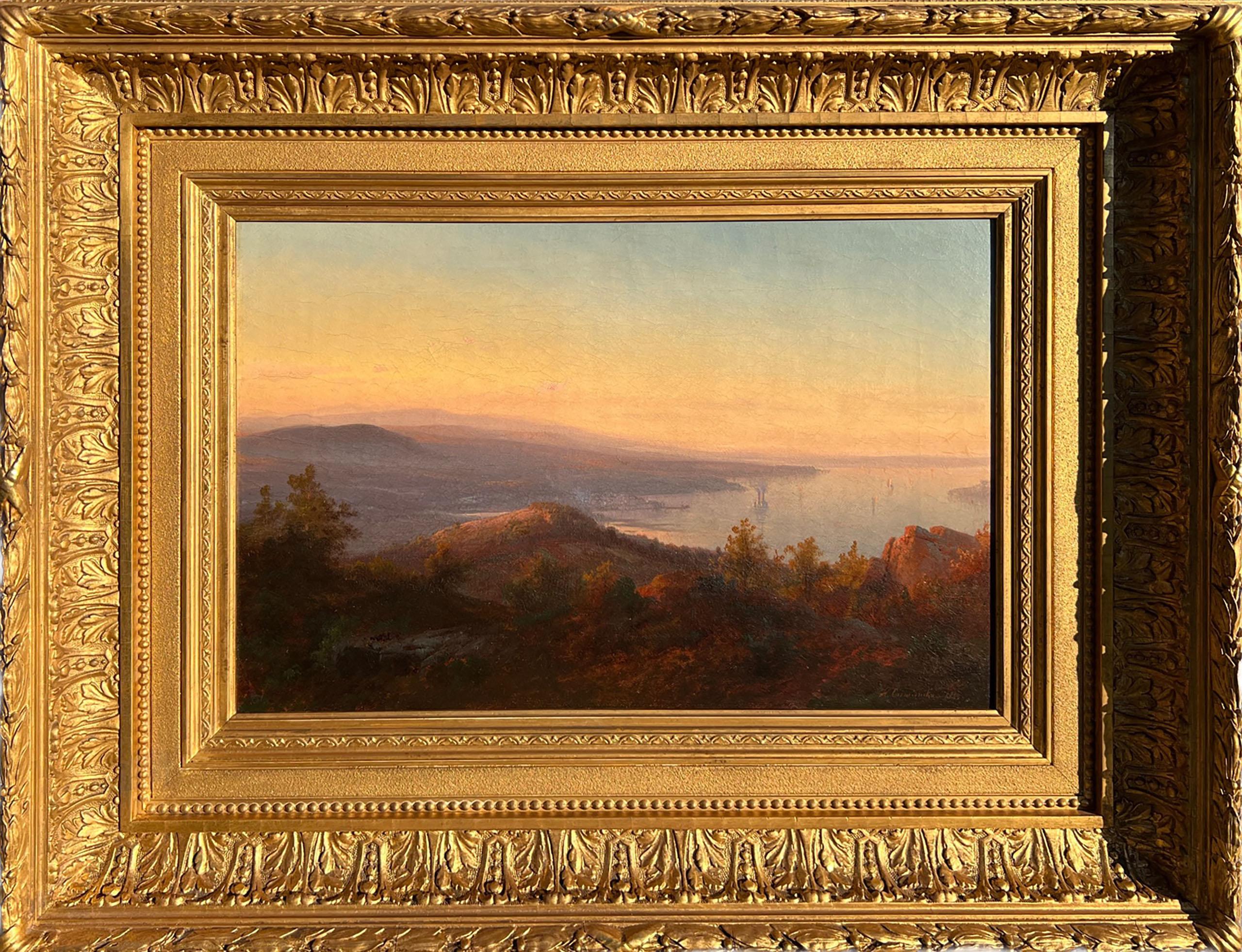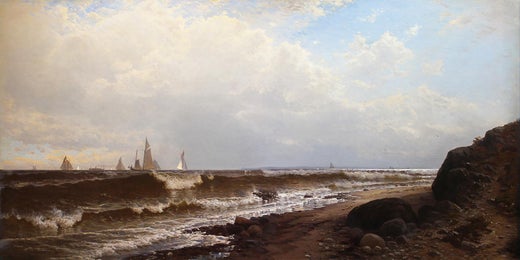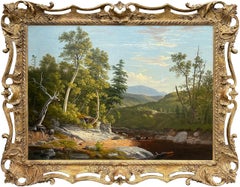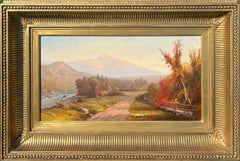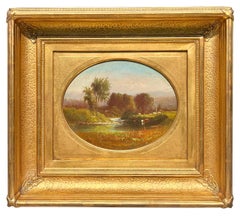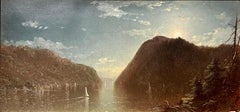Items Similar to Scene in the White Mountains by Alfred Thompson Bricher (American, 1837-1908)
Want more images or videos?
Request additional images or videos from the seller
1 of 3
Alfred Thompson BricherScene in the White Mountains by Alfred Thompson Bricher (American, 1837-1908)1864
1864
$23,000
£17,371.36
€20,076.15
CA$32,261.02
A$35,877.38
CHF 18,780.15
MX$437,660.38
NOK 235,979.45
SEK 221,969.14
DKK 149,855.44
About the Item
Painted by Hudson River School artist Alfred Thompson Bricher (1837-1908) , "Scene in the White Mountains" is oil on panel, measures 5.5 x 9.75 inches, and is signed and dated 1864 at the lower right. The work is framed in a period appropriate frame and ready to hang.
Alfred T. Bricher was born to Elizabeth Muir and William Bricher on April 10, 1837, in Portsmouth New Hampshire, though he grew up and attended school in Newburyport, Massachusetts. By 1858, Bricher announced himself a professional painter, though he was mainly self-taught, and set up a studio for himself in Newburyport. Within a year, he had relocated to Boston. Bricher’s subtle and serene style classified him as a premier painter of seascapes and ranked him among such other notable luminists as Martin Johnson Heade (1819-1904)—with whom he shared a studio building in Boston—and John Frederick Kensett (1816-1872). Bricher was known especially for his coastal scenes painted in Massachusetts, Maine, Rhode Island and Long Island between 1870 and 1890.
In 1868, Bricher moved with his new wife to New York City, where he exhibited for the first time at the National Academy of Design. As he gained a foothold in the New York art scene, Bricher exhibited regularly at the National Academy (elected an Associate in 1879), the American Society of Painters in Water Colors (of which he became a member in 1873), and the Brooklyn Art Association. During his lifetime, Bricher also exhibited at the Pennsylvania Academy of the Fine Arts, The Art Institute of Chicago, the Boston Athenaeum, and the Boston Art Club, among others. Today, one can see paintings by Bricher at such institutions as the Metropolitan Museum of Art
- Creator:Alfred Thompson Bricher (1837-1908, American)
- Creation Year:1864
- Dimensions:Height: 5.5 in (13.97 cm)Width: 9.75 in (24.77 cm)
- Medium:
- Movement & Style:
- Period:
- Condition:
- Gallery Location:New York, NY
- Reference Number:1stDibs: LU2151213727172
Alfred Thompson Bricher
Alfred T. Bricher (1837-1908) Marine and landscape painter Alfred Thompson Bricher is known principally for his oil and watercolor paintings of the New England coastline. He was born in Portsmouth, New Hampshire in 1837, and in 1840 relocated with his family to Newburyport, Massachusetts. Bricher moved to Boston in 1851 to seek employment, and worked as a clerk at a mercantile house while painting part-time. As an artist, Bricher was largely self-taught, but may have studied in Newburyport and at the Lowell Institute in Boston. In 1858 he began painting full-time and established a studio in Newburyport. That year he made the first of many sketching trips–to Mt. Desert Island in Maine with Charles Temple Dix and William S. Haseltine–which, throughout his career, would take him to: Long Island, along the Hudson River, to Lake George and into the Catskill and Adirondack Mountains of New York; to New Jersey; throughout Massachusetts; to Conway, the White Mountains, and elsewhere in New Hampshire; and along the coast of Maine. In 1859 Bricher opened a studio in Boston, though he continued to visit and work in and around Newburyport as well. In June of 1866 he made a sketching trip along the Mississippi River, and into Iowa, Wisconsin and Minnesota. During the 1860s, Bricher collaborated with L. Prang and Company to produce chromolithographs of his paintings. One of the last great Luminist artists, Bricher was described by fellow painter William S. Barrett as “not a studio painter,” but a “lover of true nature.” In 1868, Bricher and his bride, Susan Wildes of Boston moved to New York City. In 1871 the artist began sketching along the coast of Rhode Island. Around 1874 he made his first trip to Grand Manan Island in New Brunswick, Canada. Shortly after this the artist probably traveled to England, for in 1876-77 he began exhibiting English subjects. In 1890 he built a home in New Dorp, Staten Island, New York where he lived until his death in 1908.
About the Seller
5.0
Recognized Seller
These prestigious sellers are industry leaders and represent the highest echelon for item quality and design.
Established in 2004
1stDibs seller since 2022
5 sales on 1stDibs
- ShippingRetrieving quote...Shipping from: New York, NY
- Return Policy
Authenticity Guarantee
In the unlikely event there’s an issue with an item’s authenticity, contact us within 1 year for a full refund. DetailsMoney-Back Guarantee
If your item is not as described, is damaged in transit, or does not arrive, contact us within 7 days for a full refund. Details24-Hour Cancellation
You have a 24-hour grace period in which to reconsider your purchase, with no questions asked.Vetted Professional Sellers
Our world-class sellers must adhere to strict standards for service and quality, maintaining the integrity of our listings.Price-Match Guarantee
If you find that a seller listed the same item for a lower price elsewhere, we’ll match it.Trusted Global Delivery
Our best-in-class carrier network provides specialized shipping options worldwide, including custom delivery.More From This Seller
View AllWhite Mountains in New Hampshire by artist William G. Boardman (1815-1895)
Located in New York, NY
Painted by Hudson River School artist William G. Boardman (1815-1895), "White Mountains in New Hampshire" is oil on canvas and measures 28 1/8 x 38 inches. The painting is signed and...
Category
19th Century Hudson River School Landscape Paintings
Materials
Canvas, Oil
Autumn Landscape (NH) by Hudson River artist Henry A. Ferguson (1845-1911)
Located in New York, NY
Painted by Hudson River School artist Henry A. Ferguson (1845-1911), "Autumn Landscape (NH)" is oil on canvas and measures 9 x 15 inches. The painting is signed and dated 1864, at th...
Category
19th Century Hudson River School Landscape Paintings
Materials
Canvas, Oil
Summer along the Boquet River, 1875 by Julie Hart Beers (American, 1835-1913)
By Julie Hart Beers
Located in New York, NY
Painted by Hudson River School artist Julie Hart Beers (1835-1913), "Summer along the Boquet River" is oil on canvas and measures 9 x 11 inches. It is signed and dated 1875 at the lo...
Category
19th Century Hudson River School Landscape Paintings
Materials
Canvas, Oil
Hudson River Landscape by American Artist Johann Hermann Carmiencke (1810-1867)
By Johann Hermann Carmiencke
Located in New York, NY
Painted by Hudson River School artist Johann Hermann Carmiencke, "Hudson River Landscape" is oil on canvas and measures 12 x 18 inches. The painting is signed and dated 1865 at the l...
Category
19th Century Hudson River School Landscape Paintings
Materials
Canvas, Oil
Hudson Highlands by Lockwood DeForest (American, 1850-1932)
Located in New York, NY
"Hudson Highlands," by Hudson River School painter Lockwood DeForest (American, 1850-1932) is oil on artists card-stock and measures 9.5 x 14 inches. The work is framed in an elegant, period appropriate frame, and ready to hang.
Lockwood de Forest was born in New York in 1850 to a prominent family. He grew up in Greenwich Village and on Long Island at the family summer estate in Cold Spring Harbor. As was customary for a cultivated family in the Gilded Age, the de Forests made frequent trips abroad. Excursions to the great museums, which were prominent on the de Forests agenda, deepened the young Lockwood's familiarity with European painting and sculpture. Though he had begun drawing and painting somewhat earlier, it was during a visit to Rome in 1868 that nineteen-year-old de Forest first began to study art seriously, taking painting lessons from the Italian landscapist Hermann David Salomon Corrodi (1844–1905). More importantly, on the same trip, Lockwood met one of America’s most celebrated painters, (and his maternal great-
uncle by marriage) Frederic Edwin Church (1826–1900), who quickly became his mentor. DeForest accompanied Church on sketching trips around Italy and continued this practice when they both returned to America in 1869. Early on in his career, de Forest made a habit of recording the date and often the place of his oil sketches, as to create a visual diary of his travels. Lockwood’s profession as a landscape painter can be primarily attributed to Frederic E. Church and his belief in the young artist’s talent.
De Forest often visited Church in the Hudson River community of Catskill where, in addition to sketching trips and afternoons of painting, he assisted with the architectural drawings and planning of Olana. In 1872, de Forest took a studio at the Tenth Street Studio Building in New York. During these formative years de Forest counted among his friend’s artists such as Sanford Robinson Gifford (1823–80), George Henry Yewell (1830–1923), John Frederick Kensett (1816–72), Jervis McEntee (1828–91), and Walter Launt Palmer (1854–1932).
Over the next decade de Forest experienced success as a painter. He exhibited for the first time at the National Academy of Design in 1872, and made two more painting trips abroad, in 1875–76 and 1877–78, traveling to the major continental capitals but also the Middle East and North Africa. His trip to the Middle East and the library at Church’s home, Olana, established his interest in design during his mid-twenties. From about 1878 to 1902, landscape painting was overshadowed by his activities and preoccupation with East Indian architecture and décor, a style that became quite fashionable in late nineteenth century America. From 1879-1883, de Forest founded Associated Artists along with Louis Comfort Tiffany, Candace Wheeler...
Category
19th Century Hudson River School Landscape Paintings
Materials
Oil, Board
View of South Pond, New York, 1879 by Ida H. Stebbins (American, b. 1851)
Located in New York, NY
Painted by Hudson River School artist Ida H. Stebbins (b. 1851), "View of South Pond, New York," 1879 is oil on canvas, measures 23 x 33 1/2 inches, and is signed and dated 1879 at the lower left. The work is framed in an elegant Barbizon style frame and ready to hang.
Ida H. Stebbins was born in January 1851 in Chelsea, Massachusetts to Mary and Isaac Stebbins, a teacher. Though scant records remain of Stebbins’ artistic training or career, various personal details of her life have been gleaned from contemporary newspapers and federal documents. By the time View of South Pond, New York was painted in 1879, she was living in Boston. Like many artists of her generation, Stebbins likely traveled throughout the Northeast region, gaining inspiration for her paintings from the landscape of New England and New York. Stebbins was likely visiting
upstate New York when she painted this sweeping view of South Pond and the surrounding mountains near Long Lake in the Adirondacks just south of Deerland. Here, Stebbins captures the stunning vermillion, burnt orange and brown tones of the autumn landscape with the style and precise rendering often seen in paintings produced by the Hudson River School.
Shortly after the completion of View of South Pond, New York, Stebbins married Frank H. Slack, a clerk, in her hometown of Chelsea on December 14, 1881 at the age of thirty. The couple moved to Hotel Comfort in Boston, where their son, Roland Stewart Slack was born on May 22, 1883. It seems likely that her husband died in the mid-1880s since on December 3, 1889, records indicate that Ida and Roland changed their last name back to her maiden name of Stebbins.
Roland Stewart Stebbins (1883-1974) inherited his mother’s interest in art, studying at the Pennsylvania Academy of the Fine Arts, Columbia University in New York, and the Art Students League of New York. He also studied at the Académie de la Grand Chaumière and the Munich Academy of Fine Arts. Today, he is remembered for his marine and genre paintings and for his legacy as a respected professor of art education at the University of Wisconsin, Madison.
On January 1, 1890, Ida married her second husband, Timothy Jarvis, in Somerville, Massachusetts. Their daughter, Ida Hazel Jarvis, was born soon after in 1893. However, the child suffered paralysis from a brain tumor...
Category
19th Century Hudson River School Landscape Paintings
Materials
Canvas, Oil
You May Also Like
Housatonic River at Cornwall
By John William Casilear
Located in Milford, NH
A fine Connecticut river landscape by American Hudson River artist John William Casilear (1811-1893). Casilear was born in New York City, began his study with master engraver Peter M...
Category
1860s Hudson River School Landscape Paintings
Materials
Canvas, Oil
“Lake George” by Alfred Thompson Bricher (1837–1908) – Signed. Dated 1867
By Alfred Thompson Bricher
Located in Jacksonville, FL
“Lake George” by Alfred Thompson Bricher (1837–1908) – Oil on Board, Signed & Dated 1867
A luminous and tranquil landscape painting by Alfred Thompson Bricher (American, 1837–1908),...
Category
Late 19th Century American Realist Landscape Paintings
Materials
Watercolor
Oil Water Landscape with Mountains
By Alfred Thompson Bricher
Located in Fredericksburg, VA
Alfred Thompson Bricher, an American artist celebrated for his exquisite marine and landscape paintings, created "Boats Sailing Between Mountains." This piece exemplifies Bricher’s m...
Category
Late 19th Century Hudson River School Landscape Paintings
Materials
Paper, Oil
1857 American Hudson River Rockland County Landscape Painting KENNEDY Gallery
By John Henry Hill
Located in New York, NY
John Henry Hill
1839-1922
Signed lower right
Dated: 1857
Sight size: 3 3/4 x 7 1/2 inches
Overall size: 7 3/4 x 11 1/2 inches
oil on panel
Good condition
Kennedy Gallery Label Verso
...
Category
1850s Hudson River School Landscape Paintings
Materials
Wood Panel
Mountain Lake Landscape
By Joseph Kleitsch
Located in Soquel, CA
Southern California Lake. Signed "J Kleitsch," which could possibly be by Joseph Kleitsch. Oil on canvas in a period giltwood frame. Image size, 16"H x 28"L.
Joseph Kleitsch was c...
Category
1920s Hudson River School Landscape Paintings
Materials
Canvas, Oil, Stretcher Bars
$4,400 Sale Price
20% Off
19th Century White Mountain Landscape, Unknown American School
Located in New York, NY
Unknown White Mountain Artist
White Mountain Landscape, 19th Century
Oil on board
5 x 9 1/4 in.
Framed: 7 3/4 x 11 3/4 in.
Category
19th Century Hudson River School Figurative Paintings
Materials
Board, Oil
More Ways To Browse
Thompson Antique
19th Century Hudson River School Paintings
Painting Signed Thompson
Thompson Oil Paintings
19th Century Landscape Hudson River School Paintings
1837 Oil
1816 Painting
Seascape Maine
Maine Seascape Paintings
Coastal Maine Paintings
Alfred Martin
John Muir
Johnson Martin Heade
Southwest Original Art Landscapes
Bright Colored Oil Paintings
New Jersey Impressionist
Church Tower
Josine Vignon
